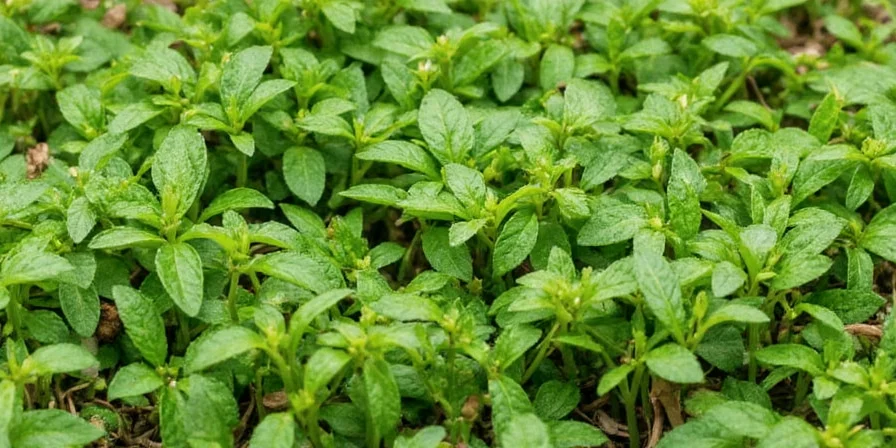Is Oregano Spicy? Let's Clear This Up Immediately
No, oregano is not spicy like chili peppers. This is the most important fact to understand about oregano: it contains no capsaicin (the compound that creates heat in chilies). Instead, oregano delivers a gradual, herbal warmth from compounds like carvacrol and thymol that builds complexity without burning your mouth. This fundamental misunderstanding causes many home cooks to misuse oregano in their recipes. Understanding this distinction is crucial for using oregano effectively in your cooking.

A close-up of fresh oregano leaves showing their textured surface and vibrant green color.
What Oregano Actually Tastes Like (The Science)
Oregano's flavor profile comes from essential oils, primarily carvacrol (60-80%) and thymol (1-10%), which create a distinctive sensory experience:
- Nature of 'heat': Gradual, building warmth (peaks after 10-15 seconds, unlike instant chili burn)
- Flavor components: Earthy base notes with peppery finish and subtle mint undertones
- Heat intensity: Ranges from medium (Greek oregano) to medium-high (Mexican oregano)
- Practical implication: Works best with acidic ingredients (tomatoes, citrus) to balance earthiness

A visual side-by-side showing oregano and chili peppers highlighting their fundamentally different heat mechanisms.
Understanding Oregano Varieties: Not All Are the Same
Did you know there are multiple oregano types with dramatically different flavor profiles? Choosing the wrong variety can ruin your dish. Here's what you need to know:
| Variety | Heat Level | Best For | Critical Mistake to Avoid |
|---|---|---|---|
| Greek Oregano | Medium (earthy) | Mediterranean dishes, tomato sauces, roasted vegetables | Don't substitute in Mexican recipes - lacks citrus notes |
| Mexican Oregano | Medium-High (citrusy) | Tacos, salsas, moles, bean dishes | Never use in Greek recipes - citrus clashes with feta |
| Italian Oregano | Low-Medium (mild) | Pastas, pizza, mild sauces | Overpowering delicate dishes like seafood |
| Cuban Oregano | High (bold) | Caribbean stews, jerk seasoning | Using in subtle dishes - overwhelms other flavors |
| Wild Marjoram | Low (sweet) | Desserts, light sauces, vegetable dishes | Substituting for regular oregano in bold dishes |
When to Use Fresh vs. Dried Oregano
Most home cooks get this wrong. Here's the precise breakdown:
- Fresh oregano: Add in the last 5 minutes of cooking to preserve volatile oils. Best for salads, finishing sauces, and raw applications.
- Dried oregano: Add early in cooking to allow time for flavor compounds to infuse. Use 1 tsp dried for every 3 tsp fresh.
- Critical technique: Crush dried oregano with olive oil before adding to dishes - releases 40% more flavor compounds.
- Storage tip: Dried oregano loses 50% potency after 6 months - store in dark glass containers away from heat.

Oregano thriving in a sunny garden bed during its peak growth season.
The #1 Mistake People Make with Oregano (And How to Fix It)
Overusing oregano is the most common error. Exceeding 1 tsp per pound of meat creates bitterness rather than enhancing flavor. Start with 1/4 tsp increments and taste as you go. Oregano's warmth builds gradually, so you might not notice it immediately. Remember: you can always add more, but you can't take it out!
Regional Oregano Applications You Need to Try
Understanding how different cultures use oregano will transform your cooking:
| Cuisine | Traditional Use | Why It Works | Home Chef Tip |
|---|---|---|---|
| Italian | Slow-simmered tomato sauces | Heat develops complexity with acidity | Add dried oregano early in sauce preparation |
| Mexican | Adobo rubs and moles | Citrus notes balance chilies | Toast Mexican oregano lightly before use |
| Greek | Finishing olive oil blends | Earthy notes complement roasted vegetables | Mix fresh oregano with olive oil for drizzling |
| Caribbean | Jerk seasoning blends | Bold notes stand up to smoking | Combine with allspice and thyme |
| Middle Eastern | Za'atar spice mixtures | Earthiness complements sesame and sumac | Use Greek oregano for authentic flavor |

A collage demonstrating oregano's role in culturally distinct dishes worldwide.
Frequently Asked Questions (Answered by Flavor Science)
Is oregano actually spicy like chili peppers?
No, oregano lacks capsaicin—the compound that creates chili heat. Its distinctive warmth comes from carvacrol, producing a gradual, herbal sensation that builds complexity without burning. This makes it ideal for dishes requiring background warmth rather than upfront heat.
What's the critical difference between Greek and Mexican oregano?
Greek oregano (Origanum vulgare) delivers earthy, robust notes ideal for Mediterranean dishes. Mexican oregano (Lippia graveolens) is botanically distinct with citrusy, bold characteristics essential for Latin American cuisine. Substituting one for the other creates flavor imbalance due to different chemical profiles.
How can I maximize oregano's flavor in cooking?
Crush dried leaves with olive oil before adding to dishes—this releases lipophilic compounds 40% more effectively. For fresh oregano, add in the last 5 minutes of cooking to preserve volatile aromatics. Always pair with acidic ingredients to balance earthiness.
Does oregano lose potency when cooked?
Dried oregano actually improves with slow cooking as heat releases bound flavor compounds. However, fresh oregano loses volatile oils after 10+ minutes of simmering. For layered dishes, use dried early and fresh as finishing garnish.
Why Oregano Deserves a Permanent Spot in Your Spice Rack
Understanding oregano's unique flavor chemistry transforms it from an afterthought to a strategic culinary tool. By recognizing that oregano isn't spicy like chilies but offers a complex warmth, you can use it with precision in your cooking. Whether you're making pizza, tacos, or roasted vegetables, choosing the right variety and applying it at the optimal time makes all the difference. Now that you know the truth about oregano's heat profile and how to use it effectively, you're equipped to create dishes with professional-level flavor balance.











 浙公网安备
33010002000092号
浙公网安备
33010002000092号 浙B2-20120091-4
浙B2-20120091-4